As an Amazon Associate I earn from qualifying purchases. When you use our links, we may earn an affiliate commission. Learn more.
Are you an avid espresso drinker? Nothing compares to a fresh shot of espresso that has been adequately brewed from your favorite coffee beans.
The aroma, taste, and rich crema on top of your coffee can set the mood for the day.
A portafilter is where the magic happens.
As the water mixes with the ground coffee, the extraction process occurs, and you’ll have a delicious custom-made espresso shot that you’ll be able to enjoy in the comfort of your home or office.
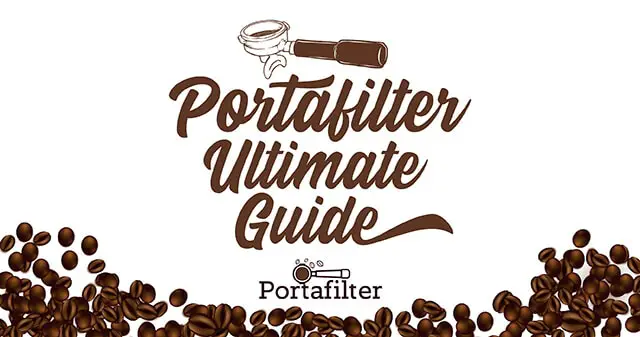
If you’ve been looking for the perfect espresso machine, then you’ve probably come across a lot of product descriptions that mention portafilters.
So, what is a portafilter? And how does it work?
In this article, we’ll help you find out everything you need to know about portafilters, so you can buy your next one with confidence.
What is a Portafilter?
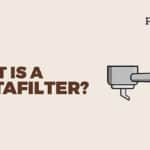
If you have ever seen an espresso machine, then you’ve probably noticed an interesting handle that sticks out where the coffee comes out of the device.
This handle contains a filter that holds and traps the ground coffee when the espresso machine is extracting an espresso shot to guarantee that you’ll have nothing in your cup except your precious espresso that you love so much.
When the hot water covers the coffee grounds, the flavor and aroma are extracted, while the filter guarantees that the coffee grounds won’t find their way into your cup.
The extracted espresso drops from the bottom of the portafilter and passes through a chute at the bottom into your cup. The handle keeps the filter in place while you’re brewing your espresso, so it locks into the espresso machine to keep the group head in place.
The main part of the portafilter is the filter basket. It’s made of metal and has tiny holes that allow only the liquid to pass through.
If you have a coffee maker, the portafilter is equivalent to the basket that holds the paper filters that you use to enjoy a tasty coffee cup. The metal portafilter basket is equivalent to the paper filters.
How to Use a Portafilter?
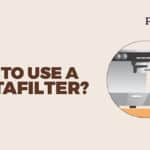
Brewing espresso isn’t a difficult task, but the process itself is a bit complicated, so you need to follow the right steps to make sure that your espresso is brewed properly.
You don’t have to be a barista to prepare a delicious cup of espresso.
First, you need to grind your espresso beans to an adequate consistency. You can buy coffee that has already been ground to prepare your espresso, but fresh beans guarantee a better taste and aroma.
If you have high-quality coffee grinders, you can grind your coffee so that it’s not too coarse or too fine.
When the coffee is too coarse, the water might not be able to extract the flavor and taste perfectly. When the coffee is too fine, coffee grinds can pass through the holes of the portafilter and affect the taste of your espresso shot.
Learning how to find the right consistency is a matter of practice. You might need to practice with several consistencies until you find an adequate one.
Once you have ground the beans to the right consistency, you need to learn how to compress the portafilter with coffee.
If the coffee is tamped too loose or too tight, the resulting espresso won’t be extracted properly, and you won’t be able to enjoy your espresso the way you want it.
After you have added the coffee and tamped it properly, you need to attach the portafilter to the group head section of the espresso machine.
Switch on the espresso machine and the hot water will immerse the coffee and extract the flavor.
Extracted espresso dispenses from the spout and into the cup. The coffee remains in the portafilter basket, so you will have a flawless espresso that is rich in aroma and crema.
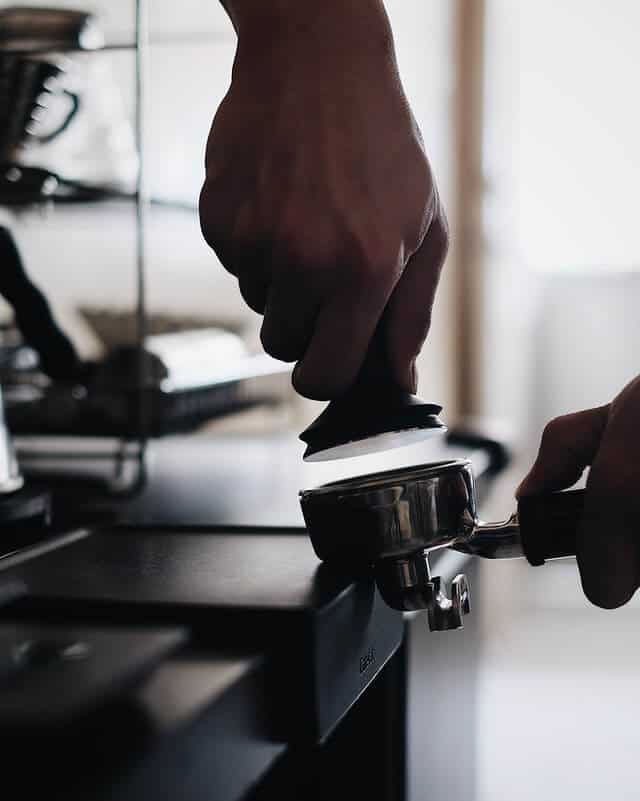
Espresso Portafilter Types
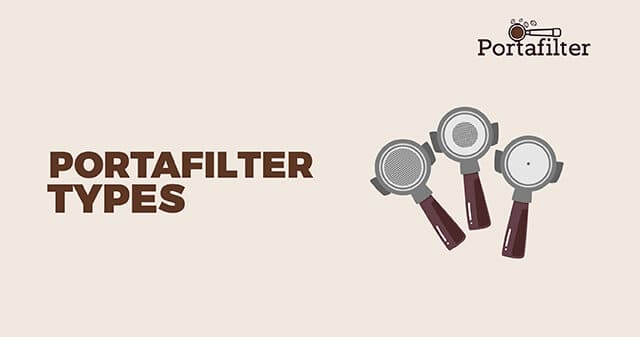
There are several types of portafilters (e.g. spouted portafilters, naked portafilter), and these are installed into various types of home espresso machines.
When you’re shopping for a new espresso machine, you need to be careful about the portafilter chosen, as this will affect how the machine operates.
Some types of filters make the espresso machine easier to operate, and that would definitely work for you if you’re not interested in spending a lot of time learning how to operate your espresso machine or need to prepare espresso fast.
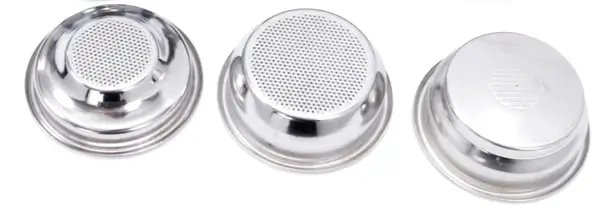
Pressurized Portafilter
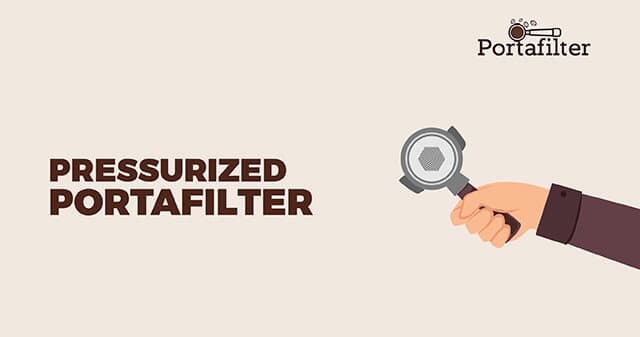
These are the most common types of filters in home espresso machines because they’re easier to operate and deliver excellent results, so you can enjoy an exceptional shot of espresso that feels like a professional barista has prepared it.
The main benefit of getting an espresso machine with a pressurized portafilter is that the portafilter does the tamping for you, so you don’t have to worry about the extraction process.
The specialty coffee won’t be packed too tight or too loose.
However, if you’re looking forward to customizing a unique espresso shot, an espresso machine with a pressurized portafilter might lack this flexibility.
Most of these home espresso machines come with pre-set settings that most users find acceptable.
Nevertheless, users won’t be able to adjust or change any of these settings to customize the brewing settings to prepare an amazing espresso shot.
Pressurized portafilters are suitable for those who need to prepare an exceptional espresso shot without having to worry about learning the details of preparing espresso. The results are consistent, and you can expect to enjoy a tasty espresso shot every time.
You can buy an espresso machine with a pressurized portafilter if you live in a busy household where everyone likes to enjoy their coffee throughout the day.
You can also get this machine in an office because you’ll be able to enjoy your tasty espresso whenever you like.
Non-Pressurized Portafilter
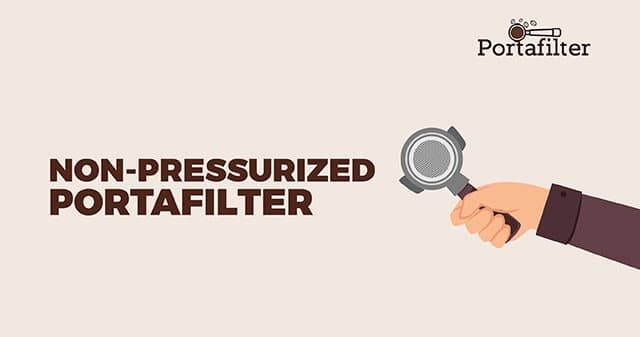
A non-pressurized portafilter is what you can expect to get on a semi-automatic espresso machine. Such a machine will be more affordable but also allow for more flexibility when you’re preparing your espresso.
These filters are either 49 or 53 mm in diameter.
If you plan on buying an espresso machine with a non-pressurized portafilter, you need to have some knowledge about picking the right level of the coarseness of the ground and also make sure that the coffee is adequately tamped for maximum extraction.
Most commercial machines at specialty coffee shops use non-pressurized portafilters. Some of these commercial machines have bigger spouted portafilters with a diameter of 58 mm.
They’re usually more durable than espresso machines designed for home use. The metal used to make these spouted portafilters is of higher quality, improving the extraction process.
Baristas and more experienced users prefer these non-pressurized filters because they’re able to customize their espresso shots. If you like to have more control over your espresso, then you need to buy an espresso machine with a non-pressurized filter.
Every time you brew an espresso shot, the taste and flavor will be different every time depending on the coffee’s consistency and how it’s tamped into the filter.
Nevertheless, you need to understand the process of brewing an espresso shot won’t be as straightforward. A little training and learning are needed before you can prepare an exceptional espresso shot.
Bottomless Portafilter
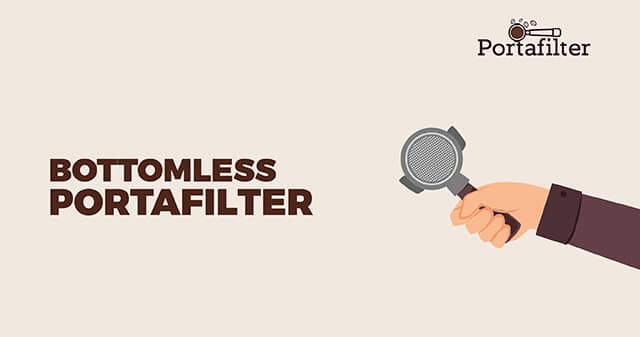
A bottomless portafilter, also called a naked portafilter, is used to pull naked espresso shots.
More experienced users and baristas prefer to use naked portafilters or bottomless portafilters because they help you diagnose the problems with your espresso machine and espresso extraction.
If you’re planning to open an espresso bar, this might be the type of naked portafilter you need to look for when you’re shopping for an espresso machine.
Bottomless portafilters allow you to see how the espresso drips through the basket, so you’ll be able to see what goes wrong if your espresso shots aren’t that good.
A bottomless portafilter will allow you to get more crema from your fresh beans because the coffee grounds won’t get with any other surface that might affect the oil content that produces the rich crema on top of your espresso shot.
The tiny crema bubbles will stay intact and will add this special taste to your espresso shot as they don’t get in touch with the spout or any other surface that might affect them.
Moreover, more avid espresso drinkers believe that a bottomless portafilter will improve the flavor and aroma of your espresso. These naked portafilters are easier to clean and will improve the taste of your espresso.
Transparent Portafilter
A transparent portafilter is made of acrylic and behaves just like one that is made of metal to pull the perfect shot of espresso.
The process of making an acrylic portafilter isn’t easy and accordingly expensive, so it’s unlikely to see a transparent one in espresso machines that were designed for home use.
Most people, however, prefer a metal portafilter that would last longer and guarantee that your espresso machine will be easy to clean and use. If you need a fancy transparent portafilter, you might have one custom-made for your coffee machine.
Dual Wall Portafilter
If you’re using pre-ground beans in your home espresso, then you might need to look for an espresso machine that has a dual-wall portafilter. This will help add more crema to your coffee, which is usually challenging to obtain if you’re using pre-ground beans.
The crema is created when the extracted espresso shot is pressurized even more through a secondary wall where the liquid passes through a pinhole, creating a layer of crema on top of your espresso extraction.
However, avid coffee lovers prefer to use roasted beans and grind them to the desired consistency. These freshly ground espresso beans will create a rich crema that you would enjoy on top of your espresso.
Portafilter Basket Types
Portafilter baskets come in several shapes and sizes. Ridged filter baskets are kept in place thanks to a metal spring and indentation that seals the basket in place and guarantees that it won’t move even when you’re trying to clean it out of the residue.
A ridgeless basket lacks the metal indentation, so it might move while you’re trying to get rid of pucks after espresso extraction.
Nevertheless, ridgeless filter baskets are considered to be cleaner because the coffee doesn’t accumulate between the ridges.
Whether you choose a ridged or ridgeless filter basket, the quality of your espresso will mostly depend on the design of the portafilter, and the quality of the beans used to extract your espresso shot.
You can also choose between single, double, and triple filter baskets. A single filter basket works with a single spouted portafilter and holds between 7 and 12 grams of coffee to prepare a single shot of rich espresso.
This single filter basket has a distinctive funnel shape.
A double filter basket has straight walls and is used to prepare a double shot of espresso, so it will hold between 14 and 21 grams of coffee. A triple filter basket can hold more than 21 grams of coffee and is usually deeper than a double filter basket.
As a result, it needs a deeper portafilter to fit properly, although it will also be used to prepare a double shot.
Portafilter baskets can also have mesh bottoms or micro holes. You need to choose a filter basket that won’t let your coffee grounds pass through.
Coffee Pod Portafilter
Using coffee pods is straightforward and fun.
The coffee pod portafilter works if you’re using coffee beans that have been previously ground and tamped into ready-to-use packets that minimize guessing and guarantee that your coffee will always taste delicious.
The results are always consistent because you don’t have to worry about grinding the coffee to the desired consistency or tamping coffee into the filter basket for proper espresso extraction.
Moreover, there are several types of pods that you can choose from, so you can enjoy your favorite espresso shot whenever you like.
All you have to do is lock the coffee pod into the portafilter, lock in the handle, and then switch the espresso machine on to brew the desired amount of rich espresso. You can buy coffee pods from any brand to use with your espresso machine, so you can enjoy your customized espresso whenever you like.
After brewing your espresso, you can easily discard the pod, and your portafilter will be ready for use.
People prefer coffee pod portafilters if they’re looking for espresso machines that are effortless to use and require no training or learning.
You can choose a different roast every time to enjoy an excellent espresso shot. However, most pods are more expensive than regular coffee, and they’re only available as single shots.
Nevertheless, these coffee pods are specifically designed for those who have no experience with preparing espresso but still want to enjoy high-quality espresso that tastes like it was prepared by a professional barista.
This free cheat sheet will improve your coffee brew by providing quick information on brew ratio, grind size, optimal brewing time, and more.
Portafilter Brands and Compatability
One important consideration when purchasing a portafilter is that it must be compatible with your espresso machine. While some portafilters can be used with a variety of different brands, we generally recommend that you purchase one specifically designed for your coffee machine.
You can get brand specific portafilter guides and reviews by clicking the links below:
- Gaggia portafilter
- La Marzocco portafilter
- La Marzocco bottomless portafilter
- Breville 54mm portafilter
Portafilter Components
A portafilter is made of different parts that work together to guarantee the maximum espresso extraction without allowing the coffee grounds to drip into your cup.
In order to extend the life of your espresso machine, you need to understand what each component does and make sure that you’re using it properly.
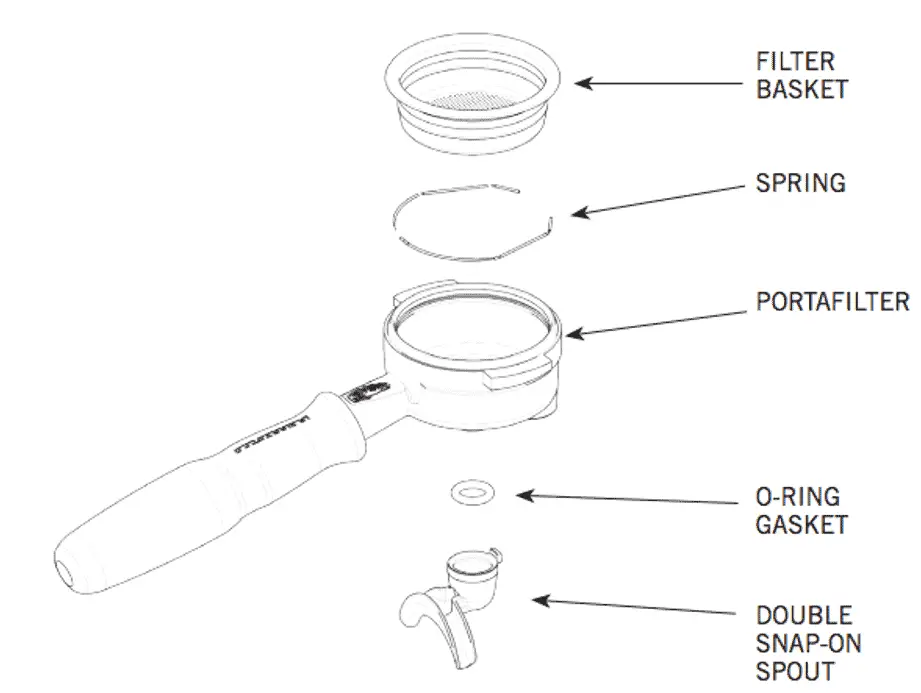
Basket
This is the most crucial part of the espresso machine. It holds the coffee grounds away from the cup while the hot water passes through to extract the flavor.
The filter basket holes are too small, so they won’t allow the coffee to pass through.
It’s either made of metal or plastic and should be cleaned after use to guarantee better espresso extraction next time.
The filter basket is usually made of chrome-plated brass, with a handle that it’s attached to it. It doesn’t react with the acids in the coffee and guarantees that your espresso will always taste delicious.
Gauge
If the espresso machine lacks a pressure gauge, you should have a pressure gauge on the portafilter. This controls the pressure output of the espresso shot and will affect how it tastes like.
Handle
This is the exterior part of the portafilter that secures it to the group head. How the handle feels in your hands will directly impact the ergonomics of the coffee maker and how you hold and use it.
A portafilter handle will be made of plastic or wood and doesn’t get in contact with the espresso shot you’re extracting.
However, you should make sure that you’ve picked a sturdy handle that won’t break as you’re cleaning the portafilter to clean it.
Spout
This is the bottom part of your portafilter unit. It’s where the brewed and extracted espresso passes through and into your coffee mug or cup.
Some espresso makers have two coffee shoots and allow you to enjoy double espresso where the extracted espresso flows evenly.
You can use these coffee shoots to pour the espresso into different cups at the same time. Some espresso machines don’t have a spout at the bottom of the portafilter, and the portafilter is called a bottomless portafilter for obvious reasons.
If you are using a spouted portafilter I recommend purchasing a portafilter stand to make tamping easier and prevent scratching your countertop surface with the spouts!
Spring
This keeps the portafilter in place and allows you to remove it easily when it’s time for cleanup. When you’re removing the pucks from the basket, this spring will keep the basket in place.
Portafilter Sizes
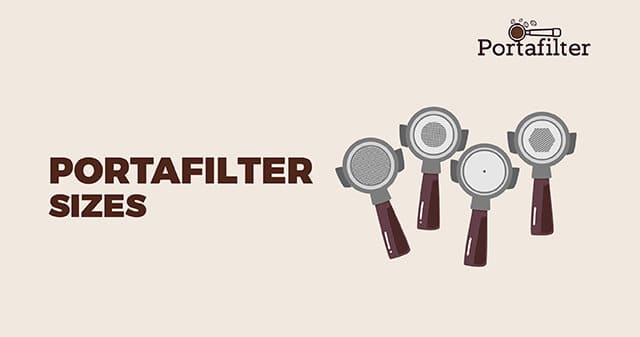
Because a portafilter is probably the main component of an espresso machine, you need to be careful while studying the various models. You must be cautious about the multiple sizes of portafilters on the market.
The group head or brew head is where the portafilter will be installed, and the size of the portafilter will be already set by the espresso maker’s manufacturer.
This means that you can’t choose a wider or smaller portafilter, even if you want to brew more or less espresso.
The most standard size for commercial and high-quality home espresso makers is a diameter of 58 mm. However, these espresso machines are rather expensive and are more suitable for people who are willing to spend more money on an excellent espresso maker.
Smaller espresso machines usually have smaller portafilters.
Some spouted portafilters have a diameter of 54 mm or even 40 mm. Smaller portafilters are less flexible because you can only fit a smaller basket to prepare a single shot.
How to Measure Portafilter Size
At first glance, portafilters might seem interchangeable, and you can switch portafilters between various espresso machines.
However, a portafilter will only work if it fits the exact spot on the group head.
Measuring a portafilter is easy as long as you’re using the right tools. You can use a machine caliber to measure the interior dimensions of the portafilter.
After measuring the diameter, you should transform the measurement from inches to decimals and then to mm by multiplying the number by 2.54.
If the portafilter basket is tapered, you should measure the narrowest diameter at the basket’s bottom. The most standard size of portafilters is either 58 mm or 54 mm.
Tamper Size
A coffee tamper is supposed to pack and compress the coffee into the basket.
As a result, it should be slightly smaller than the basket to fit right into it and squeeze the ground coffee, the way it should be done to allow for maximum extraction.
If you don’t have a set of machine calipers to measure the filter’s diameter, you can use a steel measuring tape. The taper is measured in the same way, as you should transform the measurement from inches and then to decimals. After that, you should multiply the number by 2.54 to get the diameter in mm.
Next, you should subtract 0.75 mm from the number you calculated to get the most appropriate size of the tamper.
This will be the perfect fit to compress the coffee properly.
Wrap Up
Understanding the different types of portafilters, the main components, and how to choose the best one will guarantee that you’ll be able to pull exceptional espresso shots every time.
Regardless of your experience level, you need to invest in a high-quality espresso maker and make sure that you’ve picked the right portafilter.
Different portafilters work for various espresso machines.
With the right espresso machine and portafilter, you can enjoy an excellent espresso shot that tastes like it was prepared by a trained barista.
This free cheat sheet will improve your coffee brew by providing quick information on brew ratio, grind size, optimal brewing time, and more.